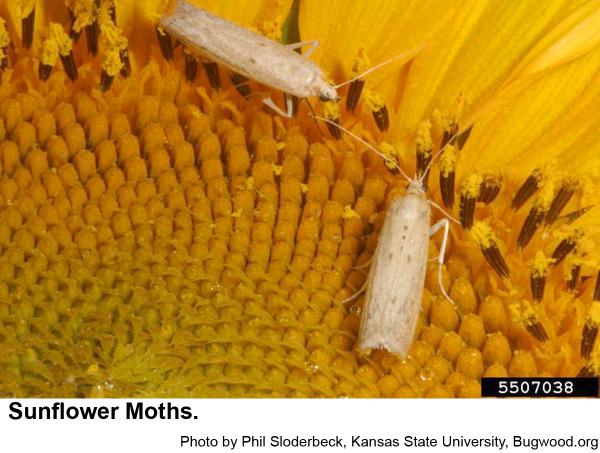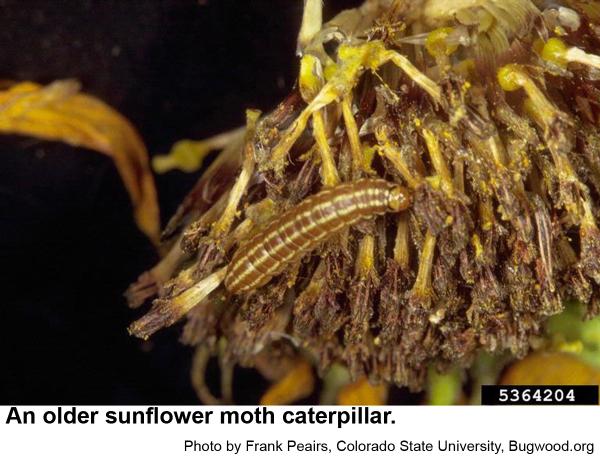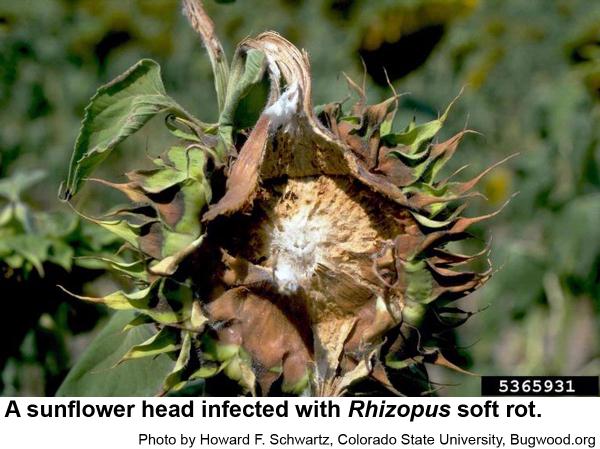Description and Biology
Sunflower moths, Homoeosoma ellectellum, are silvery-gray snout moths that wrap their wings tightly when at rest. The wings have a few small, darker spots. These 5/8 inch long moths fly to developing heads of sunflowers and lay eggs at the bases of florets. From the eggs hatch tiny, yellow worms that feed primarily on florets and pollen. Older sunflower moth caterpillars are brown- or purple-striped with light brown heads. They spin webbing as they feed on the seeds and bore into the head. They mature in about 15 to 19 days. Finally the caterpillars pupate in the webbing on the flower head or descend from flower heads on strands of silk to pupate in crevices in the soil or under crop residues. The sunflower moth is a migratory pest that breeds year round in northern Mexico and moves northward annually with successive generations. They first appear from late June to July in North Carolina. We probably have two generations per year in North Carolina because under warm conditions, the moths can complete a generation in 30 days. Sunflower moths cannot survive our winters.
Host Plants
In North Carolina, the sunflower moth is a sporadic pest of sunflowers and other composites such as coneflower. Infested heads are disfigured with dark frass pellets and tangled mats of webbing. Furthermore, their feeding damage may lead to infection by Rhizopus, a head rot fungus that requires a physical injury before it can infect the plant.
Residential Recommendations
In wild sunflowers, 50 percent or more of sunflower moth larvae may be parasitized by tiny wasp parasitoids. Certain parasitic flies of the family Tachinidae are slightly more successful because they deposit live larvae able to penetrate the flower in search of a host. If the sunflower moth caterpillars have gotten ahead of these natural controls, I recommend destroying the infested heads by freezing, burying, or wrapping tightly and sending them to the dump rather than using an insecticide that might damaging pollinators. Sunflowers and other composites attract native bees some of which are relatively rare and which would be on the endangered species lists if we knew enough about the bees to add them. If compelled to spray, you can spray the plants anytime up until the flower buds open and begin attracting pollinators or after the heads are no longer attractive to pollinators. In this latter case, I recommend spraying with a pyrethroid labeled for landscape use. Permethrin, bifenthrin, lambda cyhalothrin and other pyrethroids are available in most big box stores. The active ingredient on any pesticide is listed on the front label usually near the bottom and usually in very small font. Look for insecticides that end in "-thrin." When used as directed, pyrethroids are very toxic to insects but are not particularly hazardous to humans and pets (other than fish—avoid using pyrethroids around pools, ponds, and streams). Because the sunflower moth is sporadic in North Carolina, the population may naturally abate and next year may hardly be noticeable.
Other Resources
- Sunflower Moth. Michaud, J. P. 2013. Kansas State University Ag. Exp. Sta. & Coop. Ext. Serv.
- [Sunflower Moth]. Peairs, F. B. 2018. High Plains Integrated Pest Management
- Extension Plant Pathology Publications and Factsheets
- Horticultural Science Publications
- North Carolina Agricultural Chemicals Manual
For assistance with a specific problem, contact your local N.C. Cooperative Extension Center.
This Factsheet has not been peer reviewed.
Publication date: Oct. 30, 2019
Reviewed/Revised: Aug. 19, 2024
Recommendations for the use of agricultural chemicals are included in this publication as a convenience to the reader. The use of brand names and any mention or listing of commercial products or services in this publication does not imply endorsement by NC State University or N.C. A&T State University nor discrimination against similar products or services not mentioned. Individuals who use agricultural chemicals are responsible for ensuring that the intended use complies with current regulations and conforms to the product label. Be sure to obtain current information about usage regulations and examine a current product label before applying any chemical. For assistance, contact your local N.C. Cooperative Extension county center.
N.C. Cooperative Extension prohibits discrimination and harassment regardless of age, color, disability, family and marital status, gender identity, national origin, political beliefs, race, religion, sex (including pregnancy), sexual orientation and veteran status.



